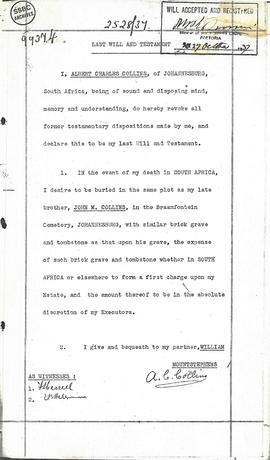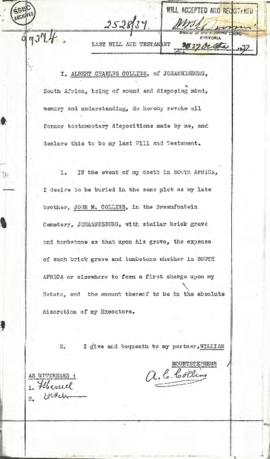Área de identidad
Código de referencia
Título
Fecha(s)
- 1936-05-04 (Creación)
Nivel de descripción
Unidad documental simple
Volumen y soporte
1 x photocopy of original will, 43 pages
Área de contexto
Nombre del productor
Historia biográfica
Founder and benefactor, born in the village of Stythian, Cornwall from which the College name is derived.
• Born 7th October 1856 at Menorlue hamlet to the west of the village of Stithians. Died c. 30th December 1937 at the age of 81.
• Family (relatively poor) were devout Wesleyan Methodists. Attended Stithian Village School and then a private school in nearby St Day.
• Apprenticed at age 14 (1870) to Martin family of carpenters.
• Eventually moved to Falmouth and apprenticed in the building trade.
Collins and Mountstephens had much in common: apart from being tradesmen and of similar age, they were both Methodists, non-smokers and teetotallers. Having completed their apprenticeships, they realised that Britain had few opportunities to offer them. In the second half of the 19thC, a period of devastating hardship in Britain, eight million people emigrated of which 146,600 of them were from Cornwall.
Collins and Mountstephens were originally headed for the USA, but fate dealt the two impatient and impulsive young men a significant hand. The ship on which they were destined to sail to the USA was delayed a few days. Instead, they boarded the SS Teuton to South Africa. They landed in Cape Town on 19th September 1880. Although offered positions in Cape Town, they went to Port Elizabeth where there was an even greater demand for their skills.
Attracted by what the discovery of diamonds offered, they set off in June 1881 for Kimberley. Here, they secured building contracts and were eventually able to establish their own building company. By 1886 they were ready for a new challenge and headed for Johannesburg where they established Mountstephens and Collins (Pty) Ltd at Oriental Chambers, 36B Pritchard Street and also invested in mining shares. Collins also invested in the Cape Fruit Farms company. Both businesses prospered, attributed to their sound work ethic, their business acumen and their sobriety.
In Johannesburg they met with Charles Leake, a fellow Methodist, at whose offices, the first Methodist Church services were regularly held on Sunday mornings. It was this small group of men who brought the Methodist Church to the Witwatersrand. At the time, Johannesburg was little more than a dusty mining camp inhabited by miners, adventurers, traders, tradesmen and con artists with limited access to the goodwill of any church. Mountstephens and Collins also encountered imperialists such as Rhodes and Jameson as well as the Transvaal’s President Paul Kruger.
Although Mountstephens and Collins Ltd made little progress during the Anglo-Boer Wars, the business flourished after 1902. The partners were able to contribute to the building of the Central Methodist Church in Johannesburg. Here they met Daniel Corlett, Leslie Kent and also Gilbert Tucker. Tucker became their accountant, a close friend, a trustee and a significant player in the founding of St Stithians. Leake and Kent also became trustees and Corlett’s company was hired to construct the original College buildings.
Collins remained a bachelor, living frugally in a single room in a building occupied by his company. He spent much of his time writing letters to his relatives living in England and New Zealand and keeping the company books. He was considered by many to be poor but could not be persuaded to indulge in the luxury of a flat.
Collins and Mountstephens had to be persuaded to leave a legacy to an educational institution as they believed that education was the duty of the state. However, Gilbert Tucker, himself an alumnus of Kingswood College in Grahamstown, convinced them of what could be achieved by establishing a Methodist school in Johannesburg. Collins and Mountstephens realised over time that state schools did not offer what they considered to be a good education: an emphasis on Christian principles and the development of leaders in social matters. Eventually they were persuaded to leave the residue of their estates to the founding of a Methodist school: St Stithians College.
• Collins died in Johannesburg in 1937 leaving a bequest to numerous charities both in South Africa and in the UK. Local beneficiaries included Methodist churches, Children’s homes, the Salvation Army, Orphanages, the YMCA, charities for the visually and physically impaired and the elderly, trades schools and the University of the Witwatersrand. Beneficiaries in the UK included children’s homes, the Royal Naval Lifeboat Association, hospitals and charities in and around his home village.
• Collins bequeathed the residue of his estate to St Stithians Trust which amounted to £42,000 (This is the equivalent of over £5 million or R68.1 million today.)
Collins’s estate was so large that it took three years to wind up, hence it was not until February 1941 that the first meeting of the Trustees took place. Mountstephens was present at the meeting and proposed the naming of the trust as the St Stithians Trust which was formally founded on 30th April 1941.
Institución archivística
Historia archivística
Part of historical collection
Origen del ingreso o transferencia
Part of the collection of historic papers accumulated by the College.
Área de contenido y estructura
Alcance y contenido
1937 Last Will and Testament of Albert Charles Collins ref 2528/37
Valorización, destrucción y programación
Acumulaciones
Sistema de arreglo
Área de condiciones de acceso y uso
Condiciones de acceso
Condiciones
Copyright St Stithians College
Idioma del material
Escritura del material
Notas sobre las lenguas y escrituras
Características físicas y requisitos técnicos
Instrumentos de descripción
Área de materiales relacionados
Existencia y localización de originales
Existencia y localización de copias
Unidades de descripción relacionadas
Área de notas
Identificador/es alternativo(os)
Puntos de acceso
Puntos de acceso por materia
Puntos de acceso por lugar
Puntos de acceso por autoridad
- Collins, Albert Charles (Materia)
Tipo de puntos de acceso
Área de control de la descripción
Identificador de la descripción
Identificador de la institución
Reglas y/o convenciones usadas
Estado de elaboración
Nivel de detalle
Fechas de creación revisión eliminación
Record created by MR 20220804



